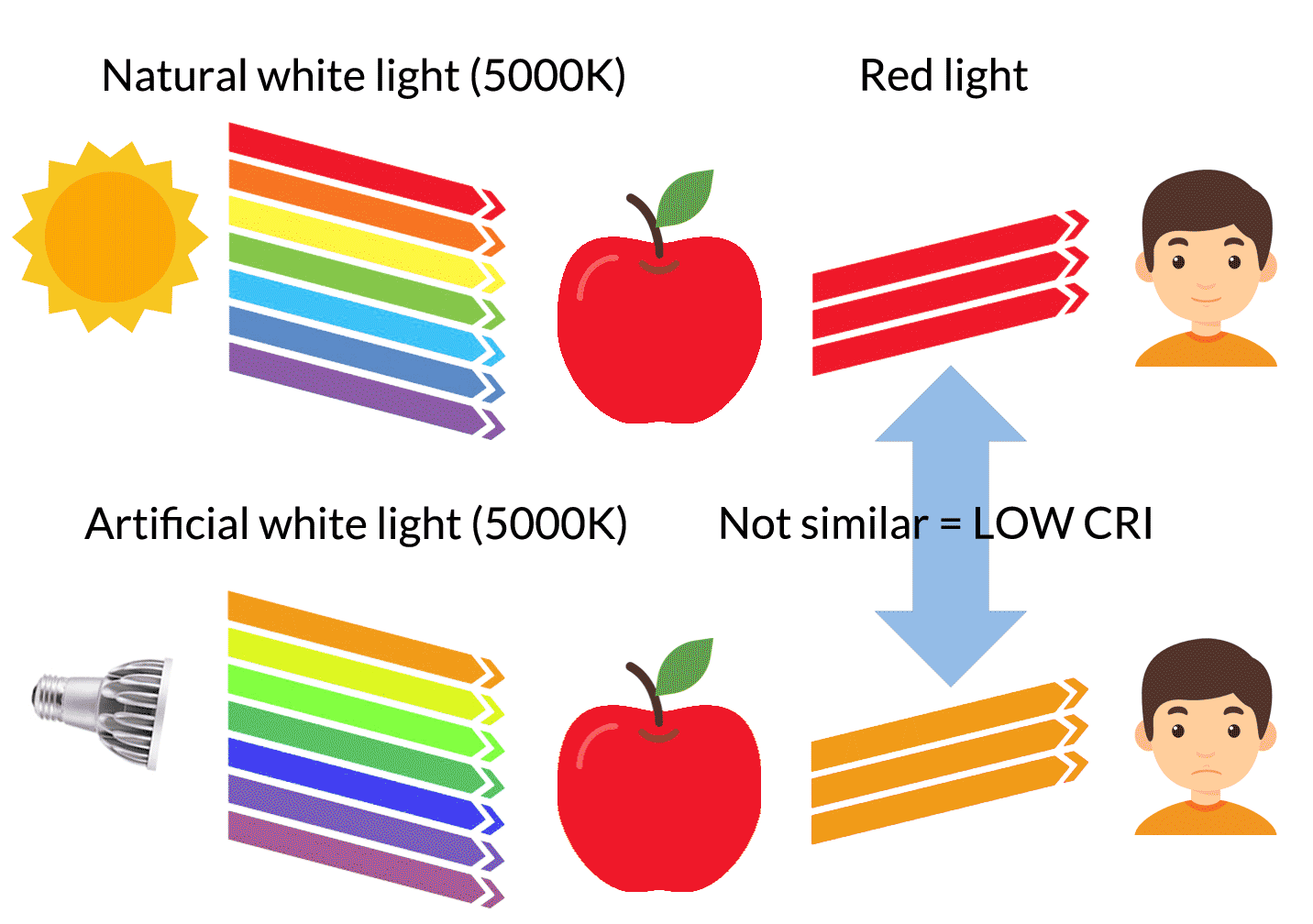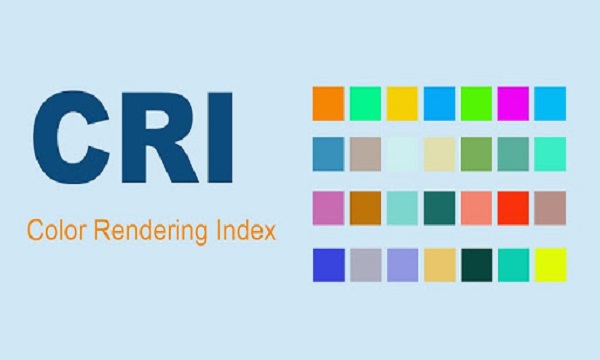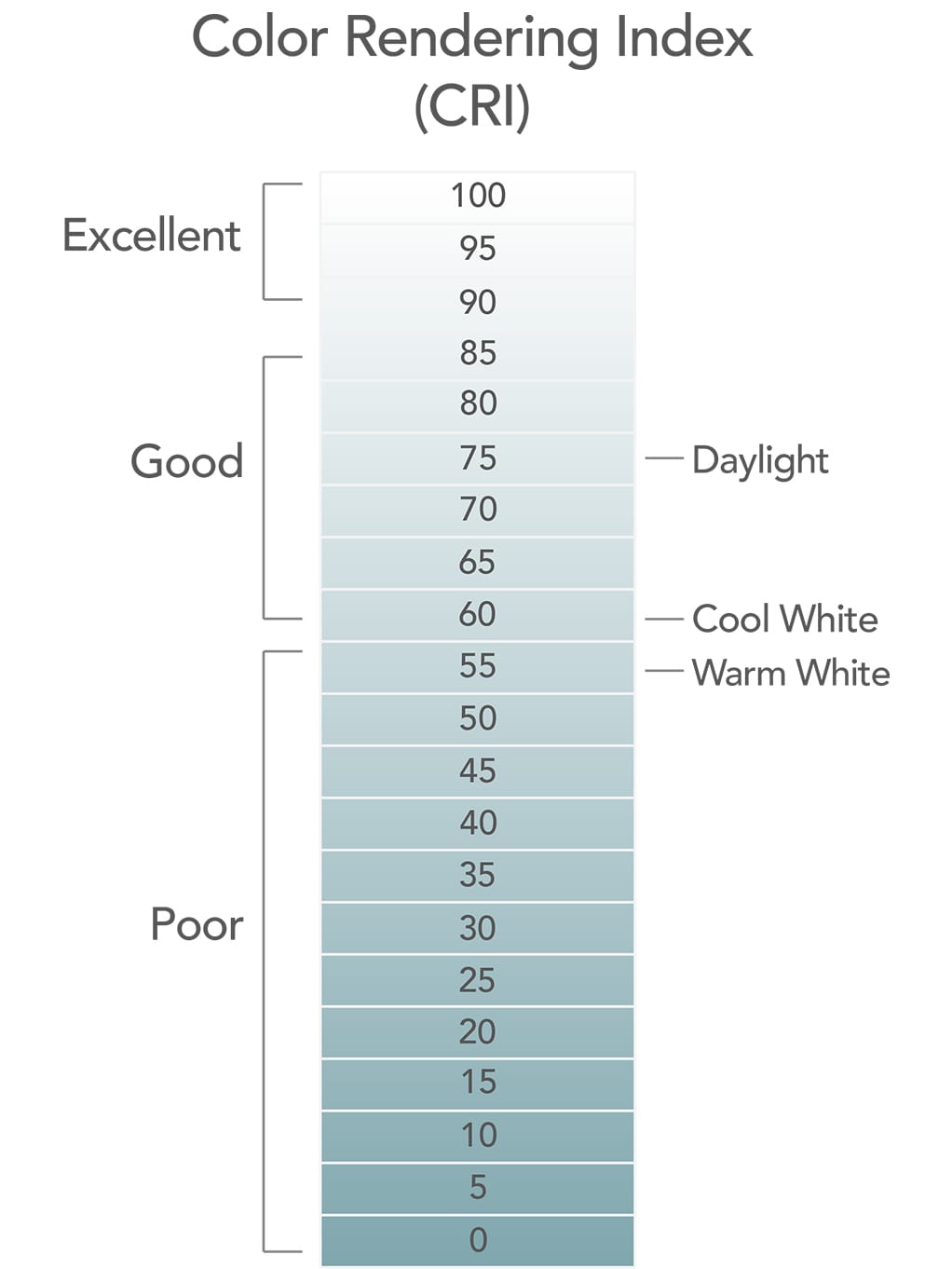Can’t tell the differences between the black and navy colored socks in your walk in closet? Could be that your current lighting source has a very low CRI! Not all light is made equal; some light renders color better than others. Color Rendering Index (CRI) is the measurement of how colors look under a light source when compared with sunlight. The index is measured from 0-100, with a perfect 100 indicating that colors under the light source appear the same as they would under natural sunlight.
This rating is also a measurement in the lighting industry to help discern naturalness, hue discrimination, vividness, preference, color naming accuracy, and color harmony.
– Lights with a CRI that is measured greater than 80 are considered to be more than acceptable for most applications.
– Lights with a CRI that is measured greater than 90 is generally considered “High CRI” lights.
In general, lights at the higher end of the scale will produce a more accurate color rendering of the objects around it. This can be vital for use in things like photography or lighting used in a museum setting. Tachyonlight’s video lights have super high CRI and TLCI. It’s best to choose lights that will make your surroundings clear, bright and as close to how they would appear in an outdoor, natural setting.
What is the Color Rendering Index (CRI)?
Put simply, the Color Rendering Index (CRI) measures the ability of a light source to accurately reproduce the colors of the object it illuminates.
This is a seemingly simple definition, but there is a lot going on, so we’ll help break it down into three parts:
Part 1: Color Rendering Index (CRI) is a score with a maximum of 100
What does it mean to measure the ability of something? Like test scores, CRI is measured on a scale where a higher number represents higher ability, with 100 being the highest.
CRI is a convenient metric because it is represented as a single, quantified number.
CRI values that are 90 and above are considered excellent, while scores below 80 are generally considered poor.
Part 2: Color Rendering Index (CRI) is used to measure artificial, white light sources
Light sources can be grouped into either artificial or natural light sources.
In most situations, we are concerned about the color quality of artificial forms of lighting, such as LED and fluorescent lamps.
This is compared to a daylight or sunlight – a natural light source.
Part 3: Color Rendering Index (CRI) measures and compares the reflected color of an object under artificial lighting
First, a quick refresher on how color works.
Natural light such as sunlight is a combination of all the colors of the visible spectrum. The color of sunlight itself is white, but the color of an object under the sun is determined by the colors that it reflects.
A red apple, for example, appears red because it absorbs all colors of the spectrum except red, which it reflects.
When we use an artificial light source such as an LED lamp, we are attempting to “reproduce” the colors of natural daylight such that objects appear the same as they do under natural daylight.
Sometimes, the reproduced color will appear quite similar, other times quite different. It is this similarity that CRI measures.
As you can see in our example above, our artificial light source (an LED lamp with 5000K CCT) does not reproduce the same redness in a red apple as natural daylight (also 5000K CCT).
But notice that the LED lamp and natural daylight have the same 5000K color. This means that the color of light is the same, but the objects still appear different. How could this be?
If you take a look at our graphic above, you will see that our LED lamp has a different spectral composition compared to natural daylight, even though it is the same 5000K white color.

In particular, our LED lamp is lacking in red. When this light bounces off of the red apple, there is no red light to reflect.
As a result, the red apple no longer has the same vibrant red appearance that it had under natural daylight.
CRI attempts characterize this phenomenon by measuring the general accuracy of a variety of objects’ colors when illuminated under a light source.
The development of CRI
In the era of incandescent light bulbs, CRI wasn’t such a big deal. That’s because incandescents deliver great color rendering.
That was before incandescent bulbs began to disappear from the lighting scene, largely because of their poor energy efficiency. At first, they were replaced by more energy-efficient fluorescent lamps. Now, LED bulbs are becoming a popular alternative to fluorescents.
LEDs have been lauded for their superior energy efficiency even compared to energy-stingy Fluorescents. They also boast other benefits, such as longer life. In addition, they contain no hazardous mercury and do not shatter. So the lighting baton now is passing from fluorescents to LEDs.
LEDs with high CRI
Fortunately, LEDs boast one other crucial advantage over fluorescents. They can provide better CRI. That means you can enjoy more vibrant, realistic colors, whether you are shaving or putting on makeup in front of your bathroom mirror at home, illuminating art on a wall, or lighting a window display in a store.
Different types of light bulbs have different color-rendering abilities. At the bottom, for instance, are high-pressure sodium and mercury-vapor lights, with CRIs of about 24 and 49 respectively. Although no bulb can match the ideal color rendition of incandescents, some do a pretty good job. Fluorescent bulbs, for instance, can give decent CRI, although you have to pick and choose. Depending on coating, fluorescents have a CRI range of 50 to 85. When you pick the top fluorescents, you can get good but not great color rendition.
Modern LEDs, however, can boast CRIs into the high 95s. This means you can get nearly perfectly natural color if you choose a LED with a high CRI. This can be crucial in businesses where you are looking for attractive natural colors, such as restaurants or stores, or in homes where you want everyone to look and feel their best and your residence to look its best.
The best thing about LED lights with excellent, high CRI ratings is that they don’t cost much more than those with standard good CRI ratings. Considering the benefits of natural color rendition, it can pay in many ways to spend a little more for a higher CRI. Plus with the constant evolution of LED technology, LED performance keeps increasing and prices keep falling.




